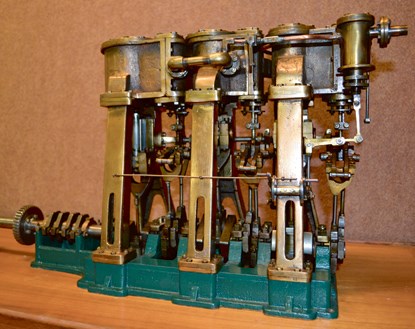
NPS, SAFR 8775 By Stephen Canright, Park Curator, Maritime History We have pulled a little gem of an engine model out of storage and are exhibiting it in the park library (March, April, May 2013). The model was shown in the old Steamship Room in the Maritime Museum between 1989 and 2007, and we are glad to see it back on public view. The model is of a three-cylinder triple expansion reciprocating engine. This was an engine that was fully developed by the early 1880s, and quickly became the dominant power plant for ocean steamships. They used relatively high pressure steam very efficiently, cycling the steam through progressively larger diameter cylinders, at progressively lower pressures. Virtually all of the expansive potential of the steam was converted into motive force. This engine was efficient enough to allow ocean steamers to profitably carry virtually any cargo over any ocean passage. This engine made the ocean freighter possible, and would finally doom sail-powered cargo vessels. Steamers had previously been confined to either short-distance runs or to the high-value passenger trades for longer ocean runs. The triple-expansion engine was largely superseded in commercial use by the more sophisticated steam turbine engine shortly after the turn of the 20th century. The type had a final resurgence in the Liberty Ship freighters of World War II. Some 2,200 Libertys were equipped with triple expansion engines, chosen for their relative ease of manufacture. San Francisco Maritime holds two full-sized engines, one in the tug Hercules, and the other in the steam schooner Wapama. The Wapama engine will eventually be displayed near the entrance to Hyde Street Pier. This finely crafted model was reputedly made by apprentices in the pattern and machine shops at the Mare Island Navy Yard, probably in the 1920s. Stop by the library, on the third floor of Building E, Fort Mason, and check it out. By Gina Bardi, Reference Librarian Come to the Maritime Library. We have resources for everyone from the novice to the expert. Here are just a few (very few...) to wet your (steam) whistle. Books: Gardiner, Robert. The Advent of Steam. New York: Conway Press, 1993. Print. Babcock & Wilcox Company. Steam, its Generation and Use. Babcock & Wilcox Company, 1963. Hawkins, Nehemiah. Maxims and Instructions for the Boiler Room. New York: T. Audel & co. 1902. Print. Articles: Mactier, Sir Stewart and W.H. Falconer. “The Development of Marine Machinery.” Liverpool Nautical Research Society. Vol. 9. 1955-1961 Sawyer, William D. “The ‘Grasshopper’ Engines of Eppleton Hall.” Sea Letter. March 1971:2-3. Print. Historical Documents: Copy of the Log of the Stmr. San Francisco from New York to San Francisco Dec. 1853. HDC105 Roy Burton Goodwin papers. HDC 1086 Collection consists of personal correspondence, certificates, licenses and other documents related to Goodwin’s career as chief engineer on steam schooners. John Felix Shearman engineering drawings. HDC1143 Design drawings of a variety of steam engines. Images: Engine with Dynamo. Turning engine for USS Olympia. P83-142a.1372g Starboard engine of the USS Oregon. P83-142a.2806g Steam Engine under construction P83-142a. 3701g Stevedore’s upright steam engine built by Moore and Scott A10.8512n Plans: Hercules. Steam engine plans. Details.HDC 128. President Hoover. Steam boilers, marine. Machine arrangement, details. HDC 460. Eppleton Hall. Steam boilers, marine. Machine arrangement, details. HDC 555. To make an appointment to see these and more, contact Gina Bardi at gina_bardi@nps.gov or 415/561-7033.
|
Last updated: March 1, 2015
